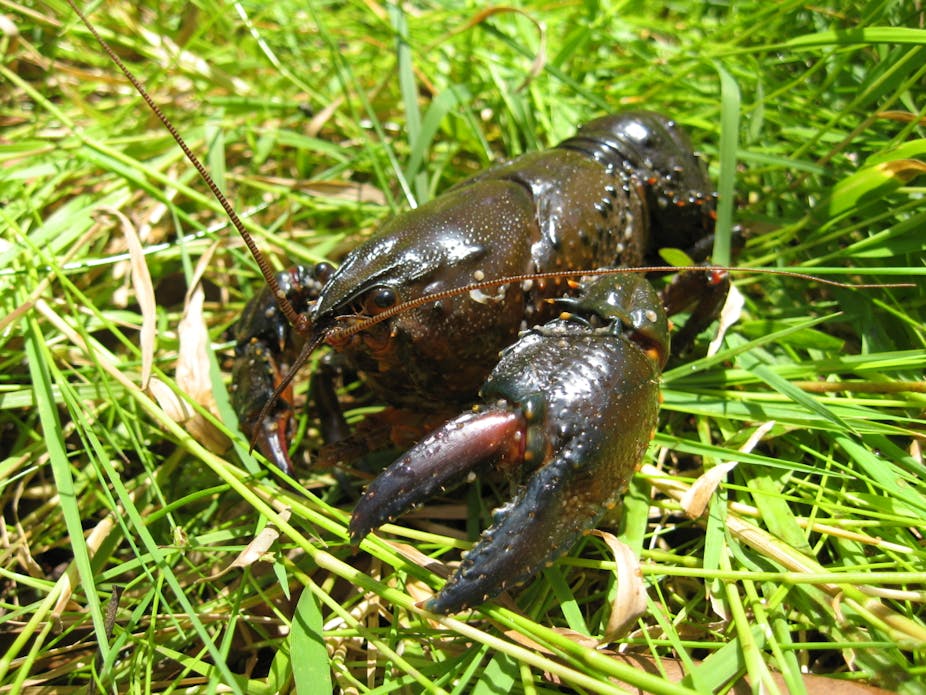You may be familiar with some of Australia’s more iconic spiny crayfish, such as the giant Murray River crayfish, Euastacus armatus, but there is an untold diversity within this endemic Australian genus. In fact, there are over 50 described species of Euastacus, and they come in all shapes, sizes and colours – from large, thorny blue monsters that fearlessly roam the streams, to delicate, little orange numbers that almost never venture from their secluded burrows.
The genus Euastacus is rather widespread in distribution, with species peppered along the eastern Australian mainland from far north Queensland to South Australia. Although a handful of species are reasonably widespread (the larger and more riverine species), most have very restricted distributions, with several species isolated to a single mountain top.
Status

Regrettably, nearly 80% of these animals are recognised as threatened on the IUCN Red List. Seventeen species are listed as critically endangered, the highest threat category for a wild species. The biology and ecology of most of these species has only been briefly examined, and expanding on this is an urgent conservation priority. The information available shows that they are a slow-growing, long-lived species, with a relatively low reproductive rate.
Most species live exclusively in densely forested areas, and all are restricted to highland habitats. The 17 critically endangered species all have distributions of less than 100 square kilometres, and in most cases less than 10 square kilometres. Of course, within a species’ overall distribution the amount of actual habitat is fragmented and limited, so these species are extremely susceptible to even small-scale, localised impacts.
Threats
Many of the species occur in national parks or other reserves, and are thus afforded indirect habitat protection. However, for some species the remaining habitat could be compromised through agricultural encroachment, urban development, road construction or forestry. Because of their severely restricted distributions, they are also susceptible to localised pollution from surface runoff, accidental spills, insecticides and general litter.

Exploitation is another threat, and takes place in the form of recreational fishing, as well as an aquarium trade facilitated through online forums. All of these species are technically “no-take” species, yet evidence of illegal collection is not uncommon, even in the depths of national parks.
There are also threats associated with introduced species. Aquatic pests such as trout, yabbies (Cherax destructor) and cane toads are of most concern. Other common and widespread pests such as feral pigs also have adverse impacts on crayfish and their habitat.
One of the most difficult threats to tackle is climate change. With continued warming and drying, these species are simply going to run out of habitat. Crayfish are poikilothermic (unable to regulate their own temperature), so are completely at the mercy of their environment. In addition, these Euastacus species are highly adapted to cool temperatures, hence, their restriction to high, cool streams. With only a very narrow altitudinal window to start with, there is literally no room to move – nowhere to run, no way to hide.
Strategy
Measures that need to be implemented for these crayfish include: targeted research (on biology, ecology and taxonomy); increased public education; habitat restoration; pest control; and emergency response planning for localised impacts. The potential direct impacts associated with climate change are a more difficult challenge.
Detailed population estimates have not yet been undertaken, and will be very difficult given the extreme rarity and reclusive nature of these animals. Population studies are currently focused on E. dharawalus, which appears to be in rapid decline due to a suite of threats, the primary one considered to be the yabby, Cherax destructor. This translocated yabby completely dominates the small area of highland streams inhabited by E. dharawalus.
Conclusion
As pointed out by Garnett and Woinarski, there is an inconsistency between the IUCN Red List status of these crayfish and their formal recognition under state and Federal legislation. The criteria used to assess their conservation status is essentially the same between the different systems – so it is not that there is a discrepancy, just that there is a process involved that may take time. Formal recognition is an important first step in driving conservation actions.
This article covers Euastacus bindal, E. clarkae, E. dalagarbe, E. dharawalus, E. eungella, E. gamilaroi, E. girurmulayn, E. guruhgi, E. guwinus, E. jagabar, E. jagara, E. maidae, E. mirangudjin, E. monteithorum, E. robertsi, E. setosus, and E. yigara.
The Conversation is running a series on Australian endangered species. See it here

